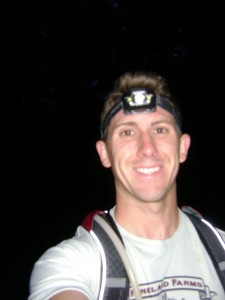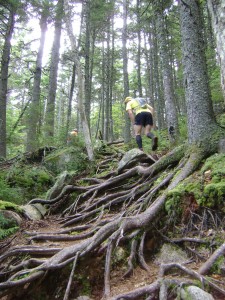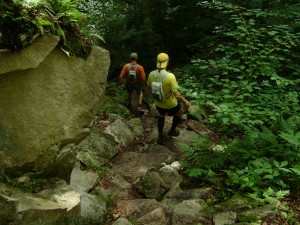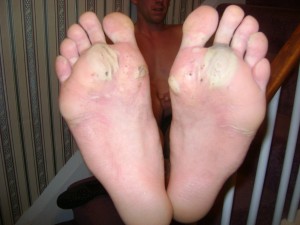When I first got the invitation following my running the Pineland Farms 50 miler by Ian and others I’ve considered running mentors for the past 2 1/2 years I was honored and excited. With little hesitation I made the commitment and let the training begin. I had always had the goal of completing a 100 mile run but never felt like I was quite there nor had I taken the time to do the planning of a more formal organized run (i.e. VT100). Over the weeks leading up to the Maine Wilderness 100 I quickly realized there was far more planning and leg work to figure out than I had guessed. I virtually wished away July looking forward to August 5th’s event; during this time I went through waves of great confidence and nervous anxiety. In the past few weeks I had put a lot of thought and planning into my food/hydration and energy needs and had a good mix of items that I had carefully laid out to strategically take advantage of at each of the 5 aid stations along the way. My dad was crewing for me and would be waiting at (approximately) mile 20, 40, 54, 71, 86 and 100. I was running with a 3 liter Nalgene bladder in an EMS pack which weighed when full of drink and food about 10/12 lbs. Waking up 3:30AM after a so-so nights sleep I did my final preparations before the short walk down the road with the other 11 folks taking part in this event for our 5:00AM start. Our group naturally fell into a single file line lit with 12 little head lamps until the sun rose enough to run without them.
Some of the times and locations may be a little off but will convey the general idea. Hogan Marquis happened to be just behind me and within an hour it was just he and I as we were working about the same pace. Interestingly it wasn’t until several hours in that we had stopped and exchanged “so that’s what your face looks like” having not met before we started. The first 48 miles are relatively flat and I had the goal of completing the first 50 miles in about 13 hours; thinking that 20 hours for the last 20 would be plenty for my goal of 33 total hours – more on that later.
The first 20 miles to crew stop #1 took about 4:40 minutes. When I reference hills they are all very relative as compared to the mountains of the last 50 miles. The first 2 miles start with a roughly 500 foot climb before dipping down as you approach Rainbow Ledges and it’s 800ft elevation gain spread out over another 2 miles. The following 11 miles remain relatively flat but included lots of technical rocky/rooty single track (who am I kidding the whole 100 mile is single track and technical – the only difference is that this section is has no serious climbs. Keeping in mind my first 50 mile time goal I wanted to “run” this as much as I could or at least move with a fair amount of urgency in my pace. A little while before hitting crew stop one my Nalgene bladder started leaking and I used my backup Camelbak bladder that I had with me as I have had this problem in the past. Buyer beware, I have had three Nalgene bladders all develop leaks within several uses. At mile 20 we reached our first crew stop where I stopped for 5 to 6 min., grabbing some more food, refilling my hydration pack and changing socks. As we headed out again you quickly approach Nesuntabunt Mtn. which has a about 1,000 ft of elevation gain over 3.5 miles with the most steep being the last mile. The 750ft. descent off Nesuntabunt takes place over the course of a steep 1/2 mile – this brings you to about mile 25.
From mile 25 to 40 the only significant elevation change is Poaywadjo Ridge which you go up and over between mile 42 and 44 – it is about 500 ft. up and 500 ft. down. Any of the ascent or descents that I have referenced or will in the future generally require bouldering that you would expect in the middle thrird of a typical mountain hike (past the relative ease of initial trail and before you get above tree line). By this I mean, the trail ceases to have any real ground and consists of large rocks but few smooth ledges thst you would expect from the more smooth walkable rocks above tree line. Do to the runable nature of much of the first 40 miles I did so, looking to bank a little time while not expending too much energy. This being said, in retrospect I think my running as much of this rough and technical footing contributed to my feet turning to junk the way they did.
Throughout the day we crossed paths with many hikers doing the entire AT, carrying their large packs of 2,000 miles worth of supplies which was in stark contrast to our minimalist packing for this event. We would often here some of their story and tell them ours. It was nice to share our mutual admiration for what we were respectivley taking part in (e.g. their multiple month treks versus our 2 day event). At mile 40 we came across Jo-Mary Rd. (which is really a logging road 12 miles into the woods) where my dad was again waiting; arrival here was 10:15 of elapsed time (3:15 in the afternoon). As my feet were feeling really hot at this point and wanting to be proactive I took about 35-40 minutes here. I soaked my feet in a stream; put some krazy glue in small blister that had popped and made sure I was fresh before our next leg. Funny story: after gluing up my foot I put my socks back on then remembered I hadn’t “lubed them up” so I took my shoes back off only to find that the glue hadn’t dried so my sock was glued to my foot. My dad and I did a little careful cutting with his Leatherman and off I went.
Leg three (13 miles) began just before 4:00PM and marks the end of anything resembling running for a while and begins the power hiking phase of the day. To this point Hogan and I had been moving together most of the day. During this leg we continued along together off and on as I was able to “hike” a little faster due to my long legs. This section includes The long approach and more short and intense summit of Little Boardman Mtn. I don’t really recall much about this section except recognizing we reached mile 50 at about 13:30 and having to put my head lamp back on a little bit before we approached crew stop #3 at mile 54 sometime around 8:30 (15 1/2 hours in). I spent about another 30 minutes at this stop – it is extremely important to me to feel as “fresh” as I can to start another leg. It’s really discouraging to start a long leg already feeling bad. After letting the legs rest a bit and changing into dry clothes (I had been previously been changing socks at every prior stop) Hogan and I headed off into the night.
It happens that this unfortunately begins the more technical/tricky half of this event. After 54 miles and 16 hours in we continued what is nearly a 2,500 foot climb of White Cap Mtn. We knew that between 9:30PM and 5:30 AM the next 8 hours would be run/hiked no more than 10 feet ahead at a time – this is about how far our head lamps illuminate. The climb of White Cap Mountain was rough going. I forget how long it took to summit but I know our pace of “power hiking” hadn’t slowed much and I was still able to push through the ever expanding pain forming in the blisters on my feet without it slowing my pace down. The view from the top of White Cap I imagine would have been amazing but it was the middle of the night so we took a few minutes to shut out headlamps off to enjoy the amazingness which was the cloudless sky. At this point, due to it being night and our elevation, I had put on a long sleeve layer but we quickly cooled off so kept moving. After this little stop I hit my first emotional point of the journey. I had been wearing a little plastic beaded bracelet my 3 1/3 year old son Christian had made for me for father’s day last year as my way of keeping him with me and him knowing I’m thinking of him. That being said, I had slipped and in catching my fall caught the bracelet on a branch which scatted the little plastic beads on the rocks. As I scurried to pick up and pocket the beads I found myself surprised by the tears that I had to fight back. I had previously explained to Hogan the story of the bracelet and at this point felt the need to warm him that if any point along the way I should get teary it’s just the exhaustion and to not worry about it to much. From “White cap Mtn.” the trail continues along a ridge connecting you to the peaks of “Hay Mtn”, West Peak and “Gulf Hagas Mtn.” These three last peaks involve steep and tricky descents and ascents connecting this range of mountain peaks. It is about a 4.5 miles down Gulf Hagas Mountain to crew stop #4. As I was moving a bit faster than Hogan at this point I moved from about 2:00AM to 4:00AM by myself to where I came into crew stop #4. The only notable things about this time along included: 1) I misread an arrow and went about 5 minutes down the wrong trail before realizing it and having to backtrack to the familiar white dashed trail I needed to be on. I wasn’t really worried about being lost rather a bit defeated about the extra .3 miles I had gone. 2) The sound of Gulf Hagas Brook, which parallels the trail for several miles, was a welcome and settling sound to break up the silence of night. Just before reaching my crew stop I kicked a rock pretty good and was convinced I broke a toe but that seemed to work itself out. A knee deep river crossing of about 200 feet was a refreshing greeting for me and my feet as I came into crew stop #4 (mile 69.5) at 4:00AM.
After changing socks and shoes again; grabbing a bite to eat and resting for a few minutes I got ready to head out again. Hogan was just getting into this stop as I was headed out, he and I previously agreed to seperate if needed, so I decided to go on alone knowing he would be catching up soon. At this point I knew my blisters were continuing to get bad and worse but the pain was fairly manageable. With the maps and elevation profile I had with me I knew the next leg of 15.5 miles was going to be the toughest of the whole wilderness but I headed out with my legs feeling strong. You are immediately greeted by a climb of nearly 1,000 feet that spans about 1 mile. This is your greeting to the Barren Chairback Range.
The Chairback Range is a stretch of 5 peaks that stretches this entire leg. I don’t have words to explain how relentless and technical this section was nor do I have pictures as I had left my camera at a crew stop and words would not do justice. This leg would have been a challenging one a hike by itself (it is actually recomended to be astrenuous two day hike by itself); never mind after 23 hours and 70 miles already covered. Within an hour of leaving for this leg I was able to put away the head lamp as I enjoyed the sun rising. It is an incredible feeling to see two sunrises and sunset on the same run. 3.5 miles into this leg as I peaked Chairback Mtn. I looked over to my right and saw in the short distance a beautiful granite faced summit even taller than the one I was standing on. I looked at my map and my worst fear was realized – yup – that’s where I was headed next. That means climbing down this mountain a little ways, follow around to that mountain and climb it. “That Mtn.” is Columbus Mtn. and required the most intense (though short) climb of the day. By this point I recognized my blistered feet were very painful, no longer able to be ignored and getting worse. Those that know me well know I’m fond of the saying “it is what it is” and I kept moving. I made my way down Columbus Mtn. though not before missing a turn and continued down an old logging road for probably close to .3 miles before realizing what I feared; I had gone the wrong way!!! I wasn’t worried about being lost I was discouraged by my wasted efforts and need to now turn around and go back to find my guiding white dashes. After finding my way back to the trail I headed up “Third Mtn.” feeling a bit defeated. At some point Hogan and his dad (who was pacing with him) had passed me and were moving along far more comfortably than I was.
At the top of “Third Mtn.” I decided I had to change my socks. I wasn’t really thinking it would help a lot but I had to do something. What I saw on the bottoms of both feet genuinely worried me; the size, depth and blackening color of these blisters were like none I had ever had and caused me to be pretty worried. At this point the miles were dragging on to what felt like a crawl (probably 1.5 miles an hour) due to the terrain, accumulated time but mostly my feet. My legs actually felt fairly strong but the location of the blisters on my feet could not have been in any worse a spot. The middle of the balls of my feet is the exact location you push off of to climb and the location you absorb going down – therefore, from mile 47 on this wear and impact was nearly unavoidable. I don’t want to be dramatic but there were many audible yelps along the way. Two things I realized helped, if even just a little: 1) Climbing – I tried to step off rocks and roots from the arch of my foot where the balls of my feet don’t even need to make contact. 2) Going down hill I found I was having to use a lot of energy to lower myself slowly and gently to the rocks awaiting; this left me fighting gravity all day.
As I began heading down “Third Mtn.” I made the decision that I was going to have to drop out. The only problem with this plan was I still had to go another 9 miles over two more significant peaks before that was an option. I happened to come across an area where I had one bar of cell phone reception and called my dad to tell him I would be coming along but was going to be significantly slower than expected. I then called my wife, Jenn, who was at her parent’s house to let her know the plan. This is when I had my second meltdown. I was sharing with her about the bracelet event from the night before and out of know where sort of lost it. I reassured Jenn that I was okay and hung up and had a good little cry right there on the side of “Third Mtn.” in the middle of Maine’s Wilderness. I pulled myself together and hobbled along. Do you see the progression of running; power hiking; walking; hobbling? The next 5 miles dragged along as I ascended and descended “Fourth Mtn.” and “Barren Mtn.” Did I mention these are the longest, tallest and steepest of the “Barren Chairback Range?” At the peak of “Barren Mtn.” I knew the last 3.5 miles were largely down hill, much easier said then done as an elevation profile will show, this is one of and the steepest and longest descent of the whole event. I hobbled into mile 86 in 32 hours and 40 min. glad to be done. I was disappointed to not have met my goal but leave with a few lessons:
1) Just because you don’t meet your goal doesn’t mean you failed.
2) This is far and away the most difficult event and greatest achievement for me to date and some 100 milers (which I WILL) do in the future may be considered easier than this accomplishment.
3) 32 hours and 40 minutes is a long time to be moving.
4) Remembering that part of the appeal of ultra running or endurance events is to find where you bodies limits are and to exceed them. For me my bodies limit was back at mile 75 and was able to exceed it by 9 miles and 6 hours after my cry on the side of the mountain.
5) My legs are stronger than I expected; my knee is more durable than I expected I’ve just got to figure out the foot issue.
6) If I can figure out how to keep my feet in good shape and on more human terrain, I’m confident I could do another event of 35 hours and well exceed 100 miles!!! To be continued . . . .
I know there are not any pictures accompanying this nor did I talk much about the scenery. I will say three things to those points: 1) I didn’t really take all that many. 2) Pictures nor my words probably wouldn’t do justice to the beauty of what I had the opportunity to see along the way and 3) pictures really wouldn’t capture the difficulty; pictures are easy to view as one segment of trail but difficult to appreciate within the context of thousands that would make up the entirety of the 100 Mile Wilderness.




